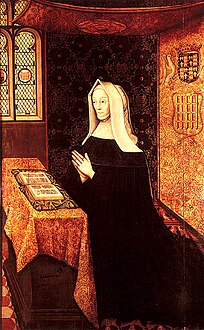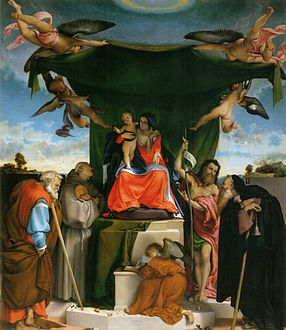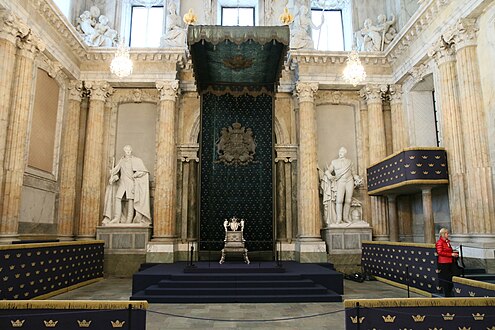Baldachin

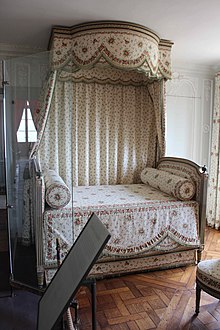
A baldachin, or baldaquin (from Italian: baldacchino), is a canopy of state typically placed over an altar or throne. It had its beginnings as a cloth canopy,[a] but in other cases it is a sturdy, permanent architectural feature, particularly over high altars in cathedrals, where such a structure is more correctly called a ciborium when it is sufficiently architectural in form. Baldachins are often supported on columns, especially when they are disconnected from an enclosing wall.[1] A cloth of honour is a simpler cloth hanging vertically behind the throne, usually continuing to form a canopy. It can also be used for similar canopies in interior design, for example above beds, and for processional canopies used in formal state ceremonies such as coronations, held up by four or more men with poles attached to the corners of the cloth.
"Baldachin" was originally a luxurious type of cloth from Baghdad, from which name the word is ultimately derived, appearing in English as "baudekin" and other spellings. Matthew Paris records that Henry III of England wore a robe "de preciosissimo baldekino" at a ceremony at Westminster Abbey in 1247.[2] The word for the cloth became the word for the ceremonial canopies made from the cloth.
Canopies of state
In the Middle Ages, a hieratic canopy of state (or "estate"), cloth of honour, or cloth of state was hung above the seat of a personage of sufficient standing, as a symbol of authority. The seat under such a canopy of state would normally be raised on a
The cloth was often simply a luxurious textile, often imported and with rich patterns, as in
Sometimes, as in the
State bed
Ceremonial
The state bed, intended for receiving important visitors and producing heirs before a select public, but not intended for sleeping in,
The state bed, a
For sleep
In Britain, monarchs slept in a state bed in the
St. Peter's Basilica
Pope Urban VIII commissioned Gian Lorenzo Bernini to design and construct a large structure that would be placed over the main altar, believed to be above the tomb of Saint Peter, in the new St. Peter's Basilica.[6] The canopy imitated cloth in bronze, as did many subsequent imitations. This famous and spectacular feature is generally called the "Baldacchino", though strictly it is a ciborium.
Bernini's design for the Baldacchino incorporated giant
All of these combine to create a feeling of upward movement.[9]
Processional canopy
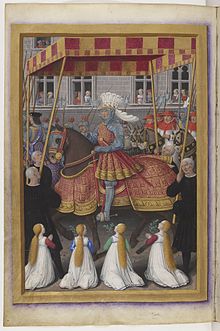
A baldachin may also be used in formal processions, including
Such canopies might be made of anything from muslin to heavy brocade, or even constructed of less flexible materials, and are supported by poles, whether affixed to a carriage, or carried by people walking on each side. An Egyptian pharaoh, for example, was escorted both in life and in death by such a canopy of estate.
Francisco Franco, the ruler of Spain from 1939 to 1975, frequently walked under a baldachin after formally proclaiming Spain a monarchy—a privilege he appropriated as de facto regent for life.
In Spanish Holy Week processions the sculptures of Virgin Mary, shown as Queen of Sorrow, use to go on their floats under canopies with embroideries Madr with gold or silver yarn
Surname Baldacchino
The surname Baldacchino comes from the artisans who used to make the Baldachin. The surname is found mainly in the islands of Malta and Sicily, particularly in Agrigento and Naro.
Gallery
-
The Grand Master of the Knights Hospitaller at Rhodes under a canopy of estate, on a dais: there is a cushion under his feet.
-
Margaret Beaufort, Queen Mother, at prayer, by an anonymous artist, about 1500
-
A cloth of honour held over the Virgin by angels, in an altarpiece by Lorenzo Lotto
-
AtMaria Leszczinska.
-
KingCardinal Alessandro Farnese
-
A baldachin inEmpire style above a daybed
-
Balachin in blue decorated withChâteau de Blois
-
Our Lady of Hope under canopy. Holy Week in Salamanca, Spain
-
Our Lady of La Naval de Manila during the enthronement rites at Santo Domingo Church
See also
- Ciborium
- Monopteros
- Aedicule
- Gazebo
Notes
- ^ Baldac is a medieval Latin form for Baghdad, whence fine silks reached Europe.
- ^ The hangings were rewoven for Marie Antoinette. The present hangings, made at Lyon by the same firm that delivered the originals, replicate the hangings as they were in 1787.
- ^ Of this grandiose bed Horace Walpole asked in a private letter "what would Vitruvius think of a dome decorated by a milliner?"
References
- ^ "Baldachin | architecture". Encyclopedia Britannica. Retrieved 2020-08-12.
- ^ Richard Ettinghausen et al., The Art and Architecture of Islam: 650-1250, 1987, Yale University Press (Yale/Penguin History of Art)
- ^ Peter K. Thornton, Authentic Decor: the Domestic Interior 1620–1920, (London, 1985) and Seventeenth-Century Interior Decoration in England, France and Holland, (New Haven & London, 1981).
- ^ Annabel Westman and Aasha Tyrrell, "The Restoration of the Harewood State Bed" (on-line Archived 2006-03-17 at the Wayback Machine)
- ^ Whannel, Kate (30 January 2023). "The family that bought the King's bed for £100". BBC News.
- Associated Press News. 11 January 2024.
- Associated Press News. 11 January 2024.
- ^ "St. Peter's - Papal Altar & Baldacchino".
- ^ "St. Peter's Basilica in the Vatican | History, description, useful information". 27 November 2016.
- ^ M. C. Miller, "The Parasol: An Oriental Status-Symbol in Late Archaic and Classical Athens," The Journal of Hellenic Studies, 112 (1992) 91-105.
Further reading
- "baldachin (architecture)". Encyclopœdia Britannica.
- Peterson, John Bertram (1907). . In Herbermann, Charles (ed.). Catholic Encyclopedia. Vol. 2. New York: Robert Appleton Company.
External links
- Burgundian example, BnF


